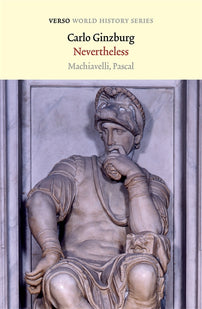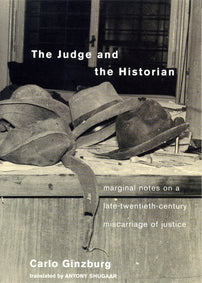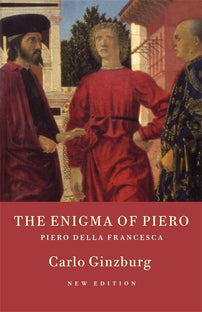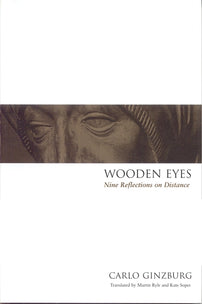‘Fascism has a Future’: Carlo Ginzburg interviewed by Joseph Confavreux
In this interview, the great historian Carlo Ginzburg reflects on Italy's current right-wing insurgency and the role history can play in helping us ask questions about the world we live in.

**This article was originally published by Mediapart on 20 September 2022.
Carlo Ginzburg is probably the most quoted and translated living historian in the world. In the tradition of the great colloquia he regularly organises, the Centre Culturel International de Cerisy has just devoted six days of study and reflection to him, in the company of old colleagues and young doctoral students.
At 83 years of age, Carlo Ginzburg has been regularly redefining the profession of historian and the way history is written for several decades. He started by forging a new plan of enquiry, ‘micro-history’, advocating a reduction of scale and a closer examination of phenomena by focusing on individuals, rather than on the large categories of masses or classes. He proposed new concepts, such as the evidential paradigm, a grammar of interpretation of indices that could approach the truth. He thus opposed both a quantitative history convinced of achieving authentic reality by accumulating numerical ammunition, and the relativistic historiography of the ‘linguistic turn’, which reduced history to a narrative like any other, independent of anything that might be considered evidence.
Ginzburg has become canonical and is sometimes quoted ritualistically, but he remains a reference in at least three areas of particular interest to our time. Firstly, on questions of religious anthropology, witchcraft, magic and heresy, to which he devoted several works, and which acquire a new resonance today as the figure of the ‘witch’ is reactivated in many fields. Secondly, on the interpretations of images and the visual, on which he has written an important work entitled ‘Fear, Reverence, Terror’. Finally, on the political and public uses of history, which he developed during his polemic with the American historian Hayden White on Holocaust denial and which take on new importance in the era of ‘alternative facts’ and ‘fake news’ coming from those in power or from their opponents.
All this would have been enough to make me want to talk to him, if the forthcoming Italian elections paving the way for a post-fascist party had not prompted me to start with a subject that is close to his heart, since he was a Jewish child in hiding during the Second World War and his father, an anti-fascist publisher and co-founder of the Einaudi publishing house, was murdered by his enemies in Rome in 1944.
Do you fear the upcoming victory of the Fratelli d’Italia party? And where would you place this party, which is sometimes referred to as neo-fascist, in the history of Italian fascism?
Yes, I am worried and afraid. This party still makes explicit references to the fascist heritage, even if it also tries to present a different face, notably by underlining, as its leader Giorgia Meloni does, her attachment to Atlanticism. So, we are not in the literal context of fascism, but it cannot be denied that many of those who vote for Fratelli d’Italia are connected to fascism. I have always avoided using the word ‘fascism’ out of its historical context. But I remember, in 2016, during the American campaign, I was doing some research in Chicago, and, watching a Trump speech, I found the word irresistible. Again, it’s not literally fascism, but there are undeniably fascist elements. With either Trump or Meloni, and even if the former doesn’t explicitly allude to the fascist legacy as the latter does, fascism has a future. It’s very hard to fight against it after the historical defeats of the left. In Italy, you could say that the left doesn’t even exist anymore, except as a residue. So, I’m very pessimistic about these elections, even if the results remain unpredictable because of the level of abstention.
After more than half a century of practice, how do you see the evolution of the profession of historian?
The event that has had the greatest effect, and has certainly not finished developing in unexpected directions, is of course the new technology around the Internet, which has multiplied available texts, access to catalogues, the possibilities of communication. However, I think it is important to insist on the possibility of using the Internet in a more sophisticated way than as a new space to answer questions, also to consider it as a place where we can find unexpected questions that we did not ask ourselves when we started working. And this presupposes a curiosity that is the hallmark of the historian’s profession and that only human teaching can provide.
You defended the journalist Adriano Sofri, a member of the revolutionary group Lotta Continua, who was accused of participating in a terrorist attack and convicted of the murder of the police commissioner Luigi Calabresi in 1972, using the research methods of history to intervene in the public and political debate. How do you see the possible role of historians in the public arena, when they are competing with pamphleteers, polemicists, and other editorialists?
The origin of my book, The Judge and the Historian: Marginal Notes on a Late Twentieth-Century Miscarriage of Justice, was a personal impulse. I was close to Adriano Sofri and convinced of his innocence. But the book was translated into many languages because it raised general questions from this particular case. I think that the essential contribution of the historian to public debate remains the search for evidence and the establishment of the truth. I always give as an example the way in which the philologist Lorenzo Valla demonstrated, in the first part of the fifteenth century, that the ‘Donation of Constantine’, by which the emperor is said to have ceded a third of the Empire to the Roman Church and to have established the temporal power of the popes, was a late forgery. In the age of fake news, we need a philology adapted to the electronic age. What is difficult to counter today is the speed with which forgeries spread, whereas it takes time to work on evidence.
But this brings us back, in an even more sensitive political context, to my insistence on the importance of evidence, against a neo-scepticism which sees no real difference between fictional narrative and historical narrative. For me, this neo-sceptical attitude, widespread in the academy, particularly in the United States, prepared the circulation of fake news that we are witnessing today. For the American historian Hayden White, who embodied this relativism, and with whom I debated in a public discussion at UCLA organised by Saul Friedländer, Holocaust denial was morally and politically unacceptable, but it was supposedly impossible to prove that it was false, because for him there was no proof. From my point of view, the defence of proof remains possible and necessary, with the tools of the historian or by reactivating the sarcastic tradition started in the nineteenth century with a parody asking if Napoleon had existed or if he was really a myth. Of course, all questions are legitimate to ask, but should the weight of proof fall first on those who say Napoleon existed or those who say he was a myth?
[book-strip index="1" style="display"]Can you explain the title of the book you recently published, Nevertheless: Machiavelli, Pascal, and clarify the political use that can be made of Machiavelli today, beyond the negative stereotype suggested by the adjective ‘Machiavellian’ as well as another stereotype, more present in Anglo-Saxon countries than in France or Italy, according to which Machiavelli would be the model of the virtuous citizen, indicating to contemporary democracies the importance of values such as liberty or the capacity to sacrifice oneself for the common good?
In 2001, I was teaching in Los Angeles. After 9/11, I decided to offer my students a detailed reading of Machiavelli’s The Prince, which is a key text for understanding secularisation. It seemed important to me to reread this, at the time of this bloody and terrible episode of religious radicalism, when the misleading theme of a ‘return of religion’ was spreading. At the heart of the text’s argument is the word ‘nevertheless’. I started from there, and I understood that it was with medieval casuistry that Machiavelli learned to reflect on the norm and the exception, through texts that he had been able to read thanks to his father. It did not seem trivial to me that a Renaissance hero, decisive for the political thought of his time, was inspired by this casuistry. If I then made an unexpected connection with Pascal, it is because I felt the need to return to the attacks carried out by the author of the Provincial Letters against this casuistry, embodied for him by the Jesuits. Even if it was in a context quite different from ours, Machiavelli raised problems that still concern us: the relationship between politics and religion, the norm and the exception, the consensus of citizens with regard to power, and so on.
I think it is necessary to distinguish between the anachronism of questions and the anachronism of answers. Doing history means starting with questions that are related to the present, but which the dialogue with documents and a different society allows us to reformulate. The idea that history teaches us to live cannot be taken literally. Rather, historical knowledge functions as an antidote to poison. I devote a chapter of the book to the analogy proposed by Machiavelli, based on Michelangelo’s David, between founding a republic and modelling a statue. Already, in The Art of War, he had compared the imposition of a form, i.e. of a behaviour, on ‘coarse men’ to the act of creating a beautiful statue from a block of rough marble. For me, this is a problem that has impressive resonances with the present because it touches on the manipulation of the masses. The Mussolini regime has disappeared, but it leaves a legacy that can be reworked by different technologies.
You are an atheist and yet passionate about religion. Why in this latest book did you take an interest in a statement by Pope Francis that ‘there is no Catholic God. There is God’?
Of course, I am an atheist and I have no religious education. I am also a Jew and persecution during the war made me a Jewish child. But, as I say in the book, I am passionate about religious phenomena, and they have occupied a considerable part of my work as a historian. One cannot be interested in the history of Europe without being interested in religion in general and Catholicism in particular. It is impossible to understand the world without religion. The process of secularisation has been a shock, but it is still ambiguous, and the secular power has appropriated the symbols and instruments of religion. For me, this statement of Pope Francis is part of the long process of secularisation and its dialectic with religions. But it surprised me because I could never have imagined that a pope could declare himself a follower of a religion common to all the other peoples of the world. I then started to trace the genealogy and discovered that a similar thought had been formulated by the Italian Cardinal Martini, who was a Jesuit like Francis. That two Jesuits should agree on such an unusual statement that ‘there is no Catholic God’ led me to hypothesise that the roots of this idea may lie in the history of the religious order of which they were members.
Your friend and colleague Jean-Louis Comolli died last spring. What was his legacy to you?
His reflection on images, which combined theoretical reflection and practical knowledge in a way that is rarely found in one person. He came to film me in Bologna as part of a research project I was doing on Dante. He filmed a 25-minute sequence in which I talk about a meeting, probably fictitious, between Dante and Giotto. I was a talking head, but it made me understand what it was like to be a body caught in a frame.
You concluded the Cerisy colloquium devoted to you with a lecture entitled ‘Texts, images, reproductions, on the shoulders of Walter Benjamin’, in which you returned to the dialectic between democratisation and degradation effected on images by technological developments. At what point in history are we, from this point of view, given how the regime of images has been so completely transformed by the Internet?
We are at the heart of a historical turning point whose results are unclear, with a deep tension and ambiguity in the images that we often read in an overly simplistic way, and sometimes embarrassed by a form of political correctness. I think we have not taken the measure of what the idea that certain images are unique represents. I’m not talking so much about the availability of images on the Internet as, for example, about the idea of the Uffizi Museum in Florence to reproduce, with sophisticated electronic means, a painting by Michelangelo, The Doni Tondo, in order to sell a few copies that would not be the original yet quite close to it. In our culture, it is considered that texts can be reproduced regardless of their support or the colour of the paper, which presupposes the existence of an invisible text that can take on various reproducible material forms. A painting by Raphael, however, even if it is perfectly copied, is still a unique painting. Some images are not reproducible. And the idea of losing that would be a painful historical loss for me.
Translated by David Fernbach




